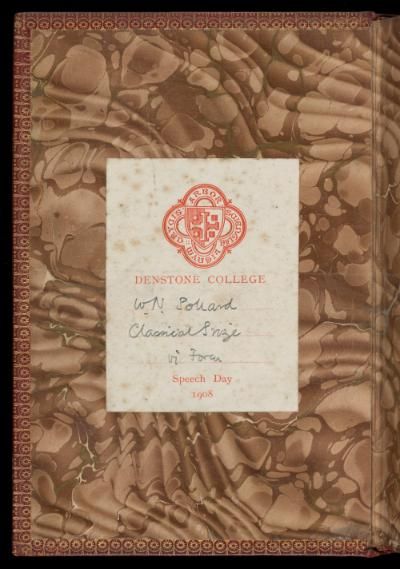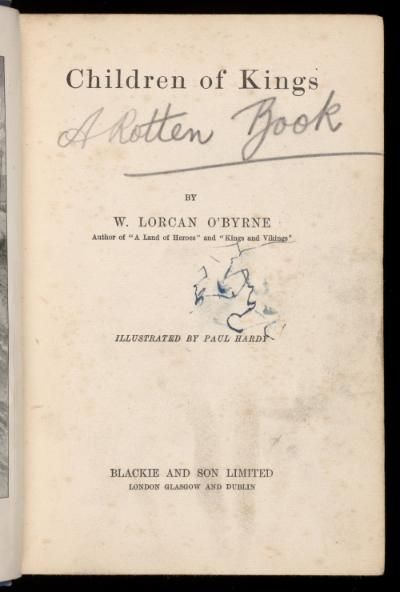Ireland’s first novel for children under the spotlight at Trinity symposium
Posted on: 13 November 2025
New online exhibition reveals how children’s drawings, comments and inscriptions uncover lives of former book owners
Ireland’s ‘first’ novel for children, a coming-of-age tale published in 1794, is the focus of a talk in Trinity College Dublin on Friday, November 14th.
The event is part of a one-day symposium celebrating the 20th anniversary of the arrival of the Pollard Collection of Children’s Books to the Library of Trinity College Dublin. The symposium is free and open to the public.
 The Pollard Collection of Children’s Books is one of the most important collections of children’s books in the world and contains over 10,500 books ranging from the 16th century to the early 20th century, amassed by Mary ‘Paul’ Pollard, the former Keeper of Early Printed Books at Trinity College Library.
The Pollard Collection of Children’s Books is one of the most important collections of children’s books in the world and contains over 10,500 books ranging from the 16th century to the early 20th century, amassed by Mary ‘Paul’ Pollard, the former Keeper of Early Printed Books at Trinity College Library.
The symposium in the Trinity Long Room Hub is a collaboration between the School of English and the Library of Trinity College Dublin and will bring together a range of experts to discuss the history, significance, and impact of the Collection.
At the conference, The Pollard Collection of Children’s Books, children’s book expert Pádraic Whyte will explain why The History of Harry Spencer has been identified as the first children’s book written by an Irish person and published in Ireland.
Printed in 1794 by John Gough of Meath Street, the author attached to the book is ‘Philanthropos’—a pseudonym used by a Mr James Delap. The book was purchased by Mary Pollard in 1964, from Hodges Figgis Booksellers for £7 10s.
“We can never know definitely if it is the ‘first’. But it is certainly one of the earliest Irish novels for children, written by an Irish person, and printed in Ireland,” explains Pádraic Whyte, Associate Professor in Children's Literature and Director of MPhil in Children's Literature in the School of English.
The coming-of-age novel follows Harry Spencer, a young gentleman who moves with his father to the countryside following financial hardship. Harry learns how to be ‘a good boy’ and acquire the virtues of charity, piety, and education. Politics of the day feature throughout including references to the Whiteboys and critiques of absentee landlords, corrupt Anglo-Irish aristocracy and the plight of the poor. The author stresses the importance of education for boys and for girls, and for Catholics as well as for Protestants.
“The book was probably read by readers of all ages, but today we might consider it a book for 10-12 year olds. The readership of this book would have been quite narrow as most of the population at the time were Catholic and spoke Irish.
“Children’s books hold incredible power. It is unsurprising, therefore, that children’s literature is at the centre of so many current debates about literacy and education. The Pollard Collection offers enormous opportunities for research on how this struggle has played out across several centuries. In The History of Harry Spencer we can see how keen the author was to highlight the importance of adolescent boys reading for pleasure; so, even in 1794, Ireland was debating how to get boys reading as well as discussing what books they should read!”
 Meanwhile, a new online exhibition examining children’s inscriptions, drawings and comments on books has also been developed to mark 20 years of the Pollard Collection of Children’s Books at Trinity Library. The exhibition, Childish Transformations: Marginalia and More in the Pollard Collections can be accessed on the Library website.
Meanwhile, a new online exhibition examining children’s inscriptions, drawings and comments on books has also been developed to mark 20 years of the Pollard Collection of Children’s Books at Trinity Library. The exhibition, Childish Transformations: Marginalia and More in the Pollard Collections can be accessed on the Library website.
Co-Curator Shane Mawe, Assistant Librarian, explains: “Library staff are always so vigilant in safeguarding the books in our collections, so it’s somewhat ironic that this exhibition celebrates and records reader engagement with books in the form of ink and pencil markings, drawings and commentary by children in some of the books in the Pollard Collection.”
Co-Curator Tony Flynn, PhD Candidate, School of English, added: “This exhibition firmly centres the child reader in the conversation of children’s books. In the Pollard Collection we can see many examples of children marking their books– marks of ownership, engagement, commentary and defacement. These marks offer access points to discover real histories of childhood. They allow us to uncover the biographies of former child book owners.”
Librarian and College Archivist, Helen Shenton said: "The scale of Mary Pollard's bequest to the Library of Trinity College Dublin matches that of James Ussher's collection in the 17th century. This collection has been transformative for this area of teaching and research in the School of English—one of the top English departments in the world. As such, Mary Pollard’s name has been added to a list of benefactors on the Gallery of the Long Room to recognise her as one of the Library’s major benefactors of the 20th century.”
More about Pollard Collection of Children’s Books:
The Pollard Collection of Children's Books – a bequest of Mary “Paul” Pollard, former Keeper of Early Printed Books – is the largest collection of children’s books in Ireland. Items date from the 16th century to the early 20th century with a special focus on Irish imprints, Irish writers, and books written for girls. At over 10,500 items the extensive holdings include works by Maria Edgeworth, Barbara Hofland, and Mary Sherwood. Some of the themes covered include heroic stories, popular adventures, schoolbooks, Latin classics, fables, moral tales, hymns, songs, chapbooks, picture books, fairy tales, and nursery rhymes. The collection came to the Library in 2005 and added significantly to its collection of juvenile-related holdings. The Pollard Schoolbook Collection was purchased in 1985. It contains 570 items, the earliest having been published in 1648 and the most recent in 1955. The collection includes books on history, English, Irish, geography, and arithmetic.
View the online exhibition on the Library website.
Media Contact:
Fiona Tyrrell | Media Relations | tyrrellf@tcd.ie | +353 1 896 3551
